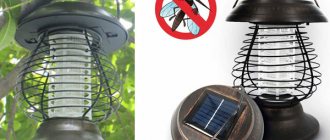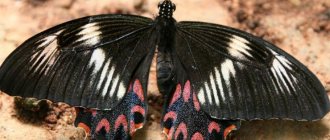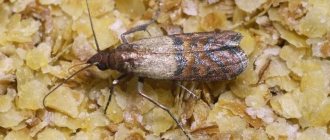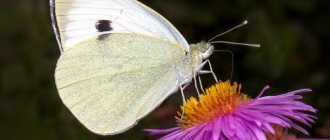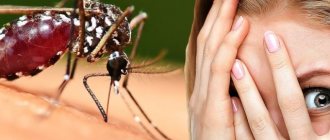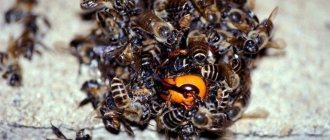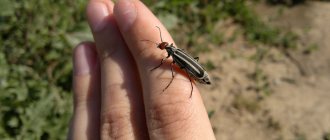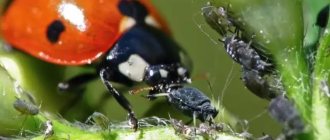Get ready for a journey into the colorful world of insects! You will see unusual butterflies and caterpillars common in the Moscow region, learn to identify them by their external signs and simply get aesthetic pleasure!
When we talk about the benefits of butterflies, we most often mean the properties of adult individuals. Thus, these insects are able to pollinate plants and attract birds to the garden. And if we mention harm, then here we are talking about the caterpillar stage, when the insect actively feeds on plants and can harm garden plantings. The butterflies themselves feed on nectar and are absolutely safe for plant health. Therefore, we will agree in advance that when we call a butterfly “harmful,” we mean its caterpillars.
Now let's take a closer look at the most common fluttering insects that you can find on your site, and determine which of them are useful and which are harmful!
Admiral - butterfly with stripes
Vanessa atalanta, wingspan 50-65 mm
The admiral is easy to recognize: there are red stripes on both sides of his wings. According to one version, it was thanks to this color that the butterfly got its name, because Russian admirals used to have ribbons over their shoulders and red stripes on their trousers. The lower wings of the insect are also decorated with red stripes, on which black dots are clearly visible. The edges of the wings are wavy.
You can meet such a beautiful butterfly not only in Russia, but also in North Africa, North America and even New Zealand. The admiral usually goes to southern countries to spend the winter, but sometimes hides under the bark of trees and remains there until spring. Previously, the admiral was included in the Red Book of Russia, but now the population has recovered.
animalreader.ru
It is not so easy to recognize the admiral's caterpillar as a future butterfly. Dark color, yellow dots on the sides of the body and frightening spikes - the insect is perfectly protected from birds and knows how to camouflage itself. It can be found from May to August on the leaves of nettles, hops and thistles.
How to attract an admiral butterfly. The Admiral loves thistles, asters and blackberries, and at the end of the season he is not averse to eating cracked plums and pears, especially if they have fermented. Place some fruit in a bowl and butterflies will flock to the smell. And to see the caterpillars, plant nettles on the site, which will also be useful as plant food.
The ancient Indians believed that if you catch a butterfly, whisper a cherished wish to it and release it into the wild, it will certainly come true. Try it!
Hawthorn - beautiful and treacherous
Aporia crataegi, wingspan 50-65 mm
Hawthorn can often be found in gardens in the Moscow region. This beautiful butterfly with white wings decorated with black veins flies from apple tree to rosehip, from rowan to plum, from grape to pear to lay its eggs, from which voracious caterpillars will soon emerge. Hawthorn is a “relative” of the famous cabbage. Prefers wetlands and easily travels long distances in search of food and nesting sites.
nature.baikal.ru
Hawthorn caterpillars are covered with thick hairs and can gnaw an entire bush or tree in a short time. They grow slowly, so they make nests in trees for the winter. If leaves entangled with mulberry threads appear on the branches, rest assured that the hawthorn has settled in your garden!
How to deal with hawthorn and its caterpillars. You can place hunting belts on trees and put up birdhouses to attract birds. In early spring, it is worth spraying the plants with a solution of copper sulfate (100 g per 10 liters of water) with the addition of 500 g of urea. If there are a lot of pests, use insecticides: Alatar, Fatrin, Kinmiks, etc. Carry out the treatment during bud break, when the caterpillars emerge from their winter nests, or in the summer after the caterpillars hatch from their eggs.
Cabbage is a dangerous pest of cabbage heads
Pieris brassicae, wingspan – 45-63 mm
Cabbage grass, or cabbage white, is familiar to every summer resident. You can find it in beds with cabbage, turnips, turnips and other cruciferous crops. The butterfly is fussily looking for a place to lay eggs, from which yellow-green caterpillars will soon appear. During the season, one individual lays up to 300 eggs!
Unprepossessing in appearance, the white hare terrifies with its appearance. You should especially be wary of females, the main difference of which is the black spots on the upper wings.
The voracious caterpillars of the white butterfly eat the leaves and prevent the head of cabbage from forming. After a while, only the veins remain from the leaf. When the food runs out, the pests crawl to new plantings.
How to deal with cabbage and its caterpillars. Safe methods include hand-picking caterpillars and catching butterflies. You can also plant marigolds, marigolds, mint or sage between the rows, which will repel pests. A good way is to cover the cabbage with a mosquito net and agro-canvas so that butterflies cannot lay eggs. Folk remedies will help by spraying 2 tbsp. mustard and 1 tsp. ground red pepper per 10 liters of water. And if there are a lot of insects, use Fitoverm, Karbofos, Actellik or another insecticide.
Urticaria - a connoisseur of birch sap
Aglais urticae, wingspan – up to 50 mm
You've probably seen this butterfly more than once, but you couldn't even imagine that the offspring of this luxurious beauty feed on stinging nettles! A special sign of urticaria is large black spots on dark orange wings. The hind wings are covered with small blue spots. The insect feeds on nectar of various flowers, and also does not refuse birch sap.
nasekomus.ru
One clutch of wren can contain up to 150 eggs, from which black, hairy caterpillars emerge. They gradually begin to eat the nettles, and at its top they build a nest of cobwebs for shelter from bad weather. After numerous molts, the caterpillar becomes yellow-black and is ready to pupate.
How to attract hives. The answer is obvious - plant nettles! But if you don’t want to see this weed in your summer cottage, try pouring a little birch sap into flat containers to attract insects. And plant lavender, oregano, echinacea, David's buddleia, spirea, bird cherry and other aromatic plants in your flower beds.
- What to plant in a flower garden to fill the garden with an unforgettable aroma
Do you want to plant fragrant flowers on your property? Then take a look at our selection!
Willow ribbonwort - twilight guest
freenatureimages.eu. Catocala electa, wingspan – 65-88 mm
The second name of this butterfly is willow ribbon. The insect leads a crepuscular lifestyle, so you are unlikely to see it during the day. The butterfly's front wings are gray and inconspicuous, but the lower wings are bright red with black edging and spots in the middle. Moreover, in males the raspberry shade predominates, and in females it is red. The Ribbonwort can also be seen in the fall. It is most often found near bodies of water, in meadows and wetlands. It feeds on tree sap.
pyrgus.de
Caterpillars of the willow tapeworm are perfectly camouflaged. The yellow-gray body is covered with small black dots, the head is brown. The insect feeds on willow and poplar leaves, so it does not harm garden crops. But if you have a willow growing on your site, be vigilant.
How to attract a ribbon girl. It would seem that the insect is nocturnal - why attract it? You can do this at least just to see this amazing butterfly. In the evening, turn on a flashlight or other artificial light source - and the ribbon fly will come to visit you.
Saturnia Io
Caterpillars are bright red. Juveniles are bright red, while older ones turn bright green. Saturnia Io has spike-like appendages with a strong poison that can poison an attacker if the insect senses even the slightest hint of danger. The poison causes toxic dermatitis, blistering, itching, pain, swelling, and necrosis of the skin. May cause skin cells to die.
Lemongrass is a long-liver in the world of butterflies
Gonepteryx rhamni, wingspan – 52-60 mm
Lemongrass, or buckthorn, is a rather inconspicuous-looking butterfly from the white butterfly family. Small dots are placed in the center of its wings, and the wings themselves imitate the shape of leaves on a tree. Nature has done its best so that these insects can hide from their enemies!
Males have a richer wing color than females. In the latter, the color of the wings is predominantly greenish-white. The development cycle of one individual takes about a year, which is a rare phenomenon in the world of butterflies. Therefore, lemongrass can safely be called a long-liver.
macroid.ru
Lemongrass lays 1-2 eggs on buckthorn leaves. Then green, smooth, slightly flattened caterpillars appear. Despite their great appetite and fastidiousness, insects do not cause much harm to trees.
How to attract lemongrass. Mostly butterflies feed on the nectar of dandelion, meadow cornflower, thistle, but they will not refuse cultivated plants. It is better to fight weeds that attract lemongrass in your summer cottage.
- How to get rid of weeds - the secrets of “clean” beds
Weed control is the main headache of all summer residents. Let’s figure it out together how to suppress the growth of weeds effectively and easily.
Poisonous caterpillars
11. Lazy clown caterpillar (Lonomia obliqua)
This peacock butterfly caterpillar can safely be called a killer caterpillar. Its spines are filled with poison, a coagulant - an anti-clotting substance.
, which can lead to human death.
Light touching of these caterpillars can lead to headache, fever, vomiting and, if left untreated, internal bleeding, kidney failure and hemolysis
.
Their venom is so powerful that scientists are studying it in hopes of developing a drug that prevents blood clots.
12. White cedar moth caterpillar (leptocneria reducta)
This caterpillar already inspires fear with its appearance. The hairs of this tiny crawling "cactus" can cause an allergic itching reaction in some people.
In addition, the caterpillars themselves live in large groups, swarming on a tree at the same time, eating every single leaf before moving on.
13. Saturnia Maya caterpillar ( Hemileuca maia
)
One look at this caterpillar should discourage you from touching it. It is covered with hollow spines attached to a poisonous sac, and touching it will not only cause itching and burning, but will also lead to nausea
.
They live mainly on oaks and willows from spring to mid-summer.
14. Caterpillar ( Orgyia leucostigma)
)
This caterpillar is easy to spot because of its red head, black back, and yellow stripes on its sides. Besides the fact that this caterpillar stings unpleasantly
, it is considered a tree pest, eating everything woody in its path.
But try to remove it from the power source, and you will be in trouble.
15. Carnivorous caterpillars
While these caterpillars won't kill you, they do eat other insects, which is quite unusual for a caterpillar's usual vegetarian diet.
And remember, if a caterpillar has spines or hairs, it is better not to touch it, as most likely it may be poisonous
!
Malinnitsa is a modest record holder
commons.wikimedia.org by Charles J Sharp. Callophrys rubi, wingspan 26-28 mm
The raspberry and the raspberry blueberry are the same butterfly from the genus Greenfinch. It is not easy to notice it, because... the outside of the insect is brown and the inside is green. In addition, the butterfly is small and almost always keeps its wings folded for camouflage. You can meet her not only at the dacha, where she flies for flower nectar, but also in swamps and meadows. Raspberries are common in the temperate zone of Eurasia. The butterfly's habitat reaches the Polar Urals, and in the Alps it sometimes rises to a height of up to 1800 m!
insectamo.ru, author: Ponomarev A. G.
Raspberry caterpillars have a fairly rich “menu”, which includes leaves of blueberry, heather, birch, gorse, buckthorn and other plants. What about raspberries, you ask? Alas, raspberry caterpillars really will not refuse raspberry and currant leaves. But despite their food preferences, they are rare on these plants. Insects are sensitive to chemicals, so they prefer to stay away from summer cottages. In addition, this species is quite rare in nature.
Some blueberry caterpillars are able to pass themselves off as ant larvae. As a result, the ants feed the caterpillars, and the latter, without hesitation, also eat the eggs and larvae of their benefactors.
How to attract raspberries. The raspberry tree is not one of those butterflies that will circle brightly over a flower bed. But if you have clover, sweet peas or vetch, she may come briefly to collect sweet nectar.
Winter armyworm and measures to combat it
Winter cutworms develop in 2 generations. The last instar caterpillars overwinter in the soil at a depth of 20 cm. In the spring, they rise to the upper layers of the soil and pupate in small earthen burrows. In the second ten days of May, the flight of butterflies begins, which are also nocturnal.
A mechanical method of combating the caterpillars of the gnawing armyworm
Since the pest feeds at night, you will have to collect the caterpillars at the same time. No matter how inconvenient it may be, and maybe even funny, you need to go out in the dark with a lighting device and collect them. To kill the caterpillars, you need to pour half a bucket of water, add soap, and send all the collected individuals there. This work will have to be done throughout the summer season, a couple of times a week.
Biological protection of the garden from the armyworm
Various birds, frogs, fireflies and moles feed on cutworm caterpillars, but the latter are undesirable in the garden. To attract birds, you need to install several feeders on the site, and try in every possible way not to scare the birds away.
Entomophages help in regulating the population of all gnawing insects. At night, the caterpillars are eaten with appetite by ground beetles, and the eggs are damaged by Trichogramma and other riders.
Bird cherry infusion
It is often recommended to place bird cherry trees between rows of branches, but in a large garden this is very inconvenient, since you will need too many branches. To prepare the infusion you will need branches, a hammer, a large container and water. The branches need to be thoroughly softened with a hammer, placed in a container and poured with boiling water; it is best to leave for three days.
Tobacco dust, yarrow and wormwood are also not to the liking of cutworms. You can choose the amount of ingredients yourself; the most important thing in the infusion is the pungent smell. Plants should be watered with this infusion, poured directly onto the stem, at a height of up to 10 cm above the ground. The procedure must be repeated periodically, since plant essential oils disappear quickly.
Obstacles
To keep out the caterpillars, who mainly chew through plant stems, you can put barriers around the stems. The cardboards are soaked in a solution of tar soap and secured with a paper clip around the plant with a rim. However, this is not very convenient, since you will have to put a “fence” around almost every stem.
Biological products
For treatment against cutworms, a mixture of BTB and Lepidocide is also used as soon as signs of damage to the sprouts appear. The main thing is to do the treatment on time, since older larvae are more persistent.
Very effective predatory nematodes are Nemabact or “Protection” soil. This is a composite of a predatory nematode and a bacterium that is symbiotic with it. They work amazingly: the roundworm penetrates the larva with food or, excuse me, through the anus, and the bacteria decompose the insides of the pest from the inside. It turns out to be a kind of broth from the entrails, which is then eaten away by nematodes. After an empty shell remains, they leave it. Bacteria and beneficial nematodes take root well and live in open ground.
Site care and agrotechnical techniques
It was once believed that the number of pests could be reduced by deep digging to make it difficult for the caterpillars to overwinter. But, firstly, no one digs to such depth. And secondly, there is more harm from digging. Therefore, in the practice of natural farming, other agrotechnical techniques are used, namely:
- If there is too much damage this year, this bed is covered with black agrofibre for the winter and until the end of June to make it difficult for the larvae to get out. If you have to resort to such a measure, fill the bed well with organic matter - over such a long period of time, the organic matter will rot well, and in the middle of summer it will be possible to plant beans, daikon, kale or any greens on it.
- The bed can also be sown with perennial green manures of the legume family (comfrey, alfalfa) and not use it for a year. In the second winter, also layer it with organic matter and cover it with agrofibre so that the roots, tops and top layer are processed by earthworms.
- You can plant annual flowers and/or green manure around the perimeter of the site, in which the female pests will lay eggs. Annuals bloom until autumn, and their natural entomophagous enemies breed here.
It will take a lot of time to fight the fall armyworm; rather, it all depends on the desire to get rid of this pest. Only by constantly monitoring the area will you be able to first reduce the number of individuals and then protect yourself from the pest more reliably. As for chemistry, it is hardly possible to eat onions after being treated with pesticides. It is better to choose a biologically safe drug or folk remedies to combat the winter armyworm.
Swallowtail - Queen of Butterflies
Papilio machaon, wingspan – 64-95 cm
It’s hard not to notice such a butterfly! Swallowtail attracts attention with its large size and bright color. The butterfly got its name from the name of a mythological doctor who participated in the Trojan War. A special feature of the swallowtail is the “tails” up to 10 mm in length on the hind wings.
Swallowtail is found all over the world: in Europe, Asia, North America and North Africa. The butterfly population in the middle zone suffers from fires and trampling of meadows. The species is listed in the Moscow Red Book.
The bright swallowtail caterpillars resemble fantastic creatures. Immediately after birth, they begin to feed. In the Moscow region, insects prefer umbrella crops: hogweed, carrots, parsley, fennel and dill. If a caterpillar gets into a garden bed, it can quickly destroy the above-ground parts of the plants. But this happens extremely rarely, because... The swallowtail practically does not fly to summer cottages.
How to deal with swallowtail caterpillars. Carefully remove them and take them outside the site, planting them on some kind of umbrella crop. Be careful, the “horns” of the caterpillars secrete a caustic liquid, so it is better not to pick up the insect with your hands, but tear it off along with a piece of the plant on which it sits.
Caterpillars (photo)
1. Coquette caterpillar ( Megalopyge opercularis)
What does a coquette caterpillar look like? like a miniature furry animal. However, as soon as you touch it, an unpleasant surprise awaits you.
Poisonous spines hidden under its “fur” release poison, causing severe throbbing pain that can radiate to the armpit, five minutes after contact with the caterpillar. Red erymatous spots may appear at the site of contact. Other symptoms include: headache, nausea, vomiting, abdominal discomfort, lymph node involvement, and sometimes shock or difficulty breathing
.
The pain usually subsides after an hour, and the spots disappear after a few days. However, if a large amount of poison is ingested, symptoms can last up to 5 days.
2. Saddle caterpillar (Sibine stimulea)
The hoary caterpillar attracts attention with its bright colors, and believe me, you better stay away from it. Its fleshy horns are covered with hairs that secrete poison.
Touching them will cause pain similar to a bee sting, swelling, nausea and rash
which will last for several days.
Peacock's eye - the most picturesque butterfly of the middle zone
Aglais io, wingspan up to 62 mm
This butterfly will not leave any summer resident indifferent! The insect will decorate any flower garden and its offspring will not cause any harm to the garden. The round spots on the front and hind wings of the butterfly are very reminiscent of the spots on the tail of a peacock. With the help of such a cunning device, the peacock's eye often confuses birds that would like to feast on the butterfly.
dic.academic.ru
The peacock eye caterpillar is not so noticeable, although its black spines can also scare off enemies. Black caterpillars live in large colonies of up to several dozen individuals. They mainly prefer to eat nettles, thistles or hops, and less often – willow and raspberries.
How to attract a peacock eye. These butterflies are excellent pollinators. To attract them to the garden, plant flowers in shades of red, pink, orange or yellow in your flower bed. And also plant some nettles in the area.
How to control peacock eye caterpillars. An invasion of caterpillars can damage the raspberry tree, but if in the spring you treated the plantings with insecticides as standard, do not worry about the safety of the crop. It is easier to remove pest colonies manually.
Reasons for the appearance of caterpillars in an apartment or private house
Insect caterpillars emerge only from larvae. If moth eggs were found in the house, it means that an adult moth entered the house through a window or doorway. This species loves damp places, so if the ceiling leaks a little, the moth will definitely settle on it.
Also, people themselves can often bring larvae into the apartment without noticing it. Caterpillars live in cereals, walnuts or candies. They also live in flour or dried fruits. Food products are susceptible to contamination due to poor processing or long shelf life.
The reason for the appearance of caterpillars is favorable conditions for reproduction and living. In addition to ceilings, caterpillars live in beds and sofas filled with fabric. It is important to quickly get rid of parasites, otherwise they will multiply at high speed.
Mother of pearl - the enemy of apple trees, blackberries and raspberries
Argynnis paphia, wingspan up to 75 mm
The pearlwort is a fairly large daytime butterfly with an unusual spotted color. The name of the insect was given because of the iridescent greenish-silver spots by which butterflies recognize individuals of their species. In warm weather, you can see flocks of pearlworts busily flying over the flower beds. These lepidopterans are also found along roadsides, in clearings and near rivers. There are many subspecies of Argynnis paphia, each of which feeds on specific crops.
molbiol.ru
Most often found in the country are large mother of pearl. Food plants for its caterpillars are apple trees, blackberries, raspberries, and violets. The body of the larvae is covered with many villi.
How to deal with mother of pearl and its caterpillars. There are different ways to protect plants from caterpillars. The simplest is to install trapping belts or pheromone traps and inspect them regularly. Regular removal of curled leaves and attracting birds will also help. It is better to choose biological drugs: Fitoverm, Bitobaxibacillin, Entobacterin, etc.
What are caterpillars - are they insects or not?
Caterpillars are worm-like larvae of butterflies that belong to the order Lepidoptera. They hatch from eggs laid by adult butterflies and represent an intermediate stage of butterfly development. These creatures appear very tiny, but actively feed and grow. Once grown to the required size, the individual pupates, forming a cocoon. In the cocoon, a complete change in her body occurs, and from a worm she turns into a winged insect - a butterfly.
Meadow pestle is a poisonous insect
Zygaenidae, wingspan 16-38 mm
Groups of pests often flutter over flower beds in sunny weather. Insects are easy to recognize: they have rounded red spots on their dark blue or green wings. In addition, unlike other butterflies, the wings of the meadow moth are folded like a roof, like those of moths. If a butterfly is caught, it will begin to secrete repellent foam. In nature, no one hunts a butterfly. It is poisonous and itself very resistant to poisons.
Caterpillars of moths are densely covered with warts, from which small bristles protrude. Body color: yellow-green with a scattering of black spots. Caterpillars can also secrete protective substances, so it is better not to handle insects with your bare hands. They feed mainly on clover and grasshoppers.
How to attract meadow moth. Plant clover, plantain, alfalfa or thyme in the area. The butterfly will also be happy with the dandelion, but usually, on the contrary, they try to remove it from the site.
- How to get rid of dandelions on your property - useful tips for summer residents
Dandelions feel great in your area and threaten to “take over” it completely? Fight the weeds!
Caterpillars crawl (video)
6. Caterpillars of the marching silkworm (Thaumetopoea pityocampa)
Traveling silkworm caterpillars live in groups in large silken nests high on pine trees.
They follow each other from the nest to the pine needles in search of food. And as you may have guessed, contact with them is dangerous. They are covered with thousands of tiny harpoon-shaped hairs, the touch of which causes severe skin irritation.
7. Bag caterpillar (Ochrogaster lunifer)
Just like the caterpillars of the traveling silkworm, these representatives live in groups in a silk bag, emerging at night and following each other in search of food. However, the danger from them is greater.
In South America they pose a health risk. The venom contained in their bristles is a powerful anticoagulant.
. This means that if you accidentally touch them, you risk bleeding from a small cut or internal bleeding.
8. Saturnia io caterpillar (Automeris io)
This caterpillar is native to Canada and the United States, and although it looks like an adorable little thing with green spiked pom-poms, remember that they are for viewing only.
No matter how tiny their spines may seem, the poison they contain can cause painful itching and even dermatitis.
.
9. Witch moth caterpillar (Phobetron pithecium)
If you thought the coquette caterpillar looked rather unusual, admire this furry creature. The witch moth caterpillar, also called the slug monkey, is often found in orchards.
People vary in their susceptibility to these caterpillars and in some they cause unpleasant symptoms, including itching and rashes.
.
10. Hickory Bear Caterpillar (Lophocampa caryae)
It seems as if these caterpillars are dressed in winter fur coats. Most of the hairs covering their body are fairly harmless, but they do have four long black hairs on the front and back that should be avoided.
Touching them causes a rash
and more serious health problems if hairs get into the eyes.
Besides, they also bite
.
Burdock - a lover of overseas travel
Vanessa cardui, wingspan 47-65 mm
The burdock butterfly, or thistle, is often confused with the urticaria. They are really similar, but, unlike the urticaria, the burdock is much larger and has black, rather than blue, spots on its hind wings. The number of this species varies from year to year. For example, in 2009 there were especially many of them. For the winter, burdocks fly to North Africa, and then return to the European continent and begin breeding.
wallhere.com
Females lay one egg each on thistle, burdock, coltsfoot, yarrow or nettle. After hatching, the caterpillar makes a shelter out of leaves. Over the course of her life, she can change at least 7 of them. Depending on the food plant, the color of the caterpillars will also change. At the dacha, they will help fight weeds and become food for birds.
In the southern regions of Russia, burdock caterpillars can infect tomatoes, eggplants, soybeans, and melons.
How to attract a burdock. Plant cosmos, asters, saplings, David's buddleia, phlox and other plants attractive to butterflies in your flower beds. Thickets of thistles near the site will also attract the attention of thistles.
Steps
Part 1
Provide a suitable living environment
- 1
Take a suitable container.
The hairy caterpillar can be safely housed in a clear plastic or glass jar. The jar must have a lid so that the caterpillar does not escape. You can also use a cardboard box instead of a jar.
Make several small holes in the lid or take a lid with ready-made holes. The holes are necessary to allow air to enter the jar. - 2
Place a twig in the jar.
The caterpillar will need a branch to build its cocoon. Insert a small branch into the jar containing the caterpillar. The branch should lie diagonally so that the caterpillar can climb onto it when it wants to spin a cocoon.
- 3
Clean the jar regularly.
The caterpillar will leave droppings in the jar daily. It needs to be cleaned regularly. Remove the caterpillar from the jar and remove the droppings with a napkin.
- 4
Keep the jar outside.
The hairy caterpillar requires a cold environment to grow. Store the can in a safe place outside your home. A safe place for caterpillars can be a garage or shed near the house.
Part 2
Feed the caterpillar
- 1
Place the plant on which the caterpillar was found in the jar.
Caterpillars prefer plants that are familiar to them. Pick a few leaves and plants from the area where you found the caterpillar. Put them in a jar.
For example, if you find a caterpillar on a tree in the garden, pick a couple of leaves from that tree.
- 2
Feed the caterpillar leaves.
It is very beneficial for caterpillars to eat leaves. If you find a few leaves on the ground, take them and bring them into the house. Scatter them across the bottom of the jar or box containing the caterpillar. Both green and already dried leaves are suitable for this. The caterpillar needs to be fed leaves every day.
- 3
Place flowers and grass.
Caterpillars also eat flowers and grass, so pick some from outside your home. For good growth of the caterpillar, plants such as dandelions, grass, plantain and burdock will be very useful. Provide the caterpillar with fresh flowers every day.
- 4
Spray the jar regularly with water.
Hairy caterpillars do not need a container of water, especially since they can drown in it. However, the jar with the caterpillar must be regularly sprayed with water. Spray the bottom of the jar with a spray bottle every day. Thanks to the tiny drops of water, the caterpillar will not suffer from dehydration.
Part 3
Release the caterpillar
1
In winter, add fallen leaves to the jar. When winter comes, add fallen leaves to the jar with the caterpillar. They will serve as warm housing during the cold winter months. The caterpillar will eventually build a cocoon, but this will not happen until spring.
It is very important that the caterpillar does not freeze in winter. 2. Bring the jar or box with the caterpillar into the house when it builds a cocoon.
Bring the jar or box containing the caterpillar into the house when it builds a cocoon.
In the spring, the caterpillar will stop moving and remain on the branch. After a while she will build a cocoon. When this happens, the jar with the caterpillar can be brought into the house. This will allow you to better see the butterfly inside.
3
Feed the butterfly when it is born. Before the butterfly emerges from the cocoon, place a few more twigs and fresh leaves in the jar. Since the butterfly will remain in the jar for several more days, it will need these food sources.
4
Release the butterfly after two days. Watch the butterfly for a couple of days after it emerges from the cocoon. Take a closer look at her and watch how she eats leaves and grass. If you have children, this will be a great learning experience for them. However, after a few days the butterfly will have to be released into the wild in the same place where you found it. For a butterfly, unlike a caterpillar, life in a box will not be as comfortable.

